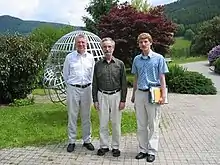Robert Seiringer
Robert Seiringer (1 September 1976, Vöcklabruck) is an Austrian mathematical physicist.


Life and work
Seiringer studied physics at the University of Vienna, where in 1999 he acquired his diploma and in 2000 with Jakob Yngvason as thesis advisor attained a doctorate. In 2005 he attained his habilitation qualification at the University of Vienna. With a Schrödinger scholarship, he went in 2001 to Princeton University. There he became in 2003 assistant professor. Starting from 2010 he is an associate professor at McGill University. In addition he is extraordinarius professor at the University of Vienna. Seiringer made substantial progress in the mathematical theory of quantum gases and particularly Bose–Einstein condensate (BEC). He partly proved the existence of BEC for interacting boson gases in the Gross–Pitaevskii limit[1] in collaboration with Elliott Lieb. They proved also superfluidity in this limit and derived the Gross–Pitaevskii equation in the special case of BEC in rotating containers. Since 2013 he is a full professor at the Institute of Science and Technology Austria (ISTA) in Klosterneuburg, Austria.
Recognition
In 2009 Seiringer received the Henri Poincaré Prize.
He was elected as a Fellow of the American Mathematical Society in the 2020 Class, for "contributions to mathematical physics and analysis in many-body quantum physics, and for service to the mathematical community".[2]
Works
- Seiringer, Robert (2013). "Hot topics in cold gases". Japanese Journal of Mathematics. Springer Science and Business Media LLC. 8 (2): 185–232. doi:10.1007/s11537-013-1264-5. ISSN 0289-2316. S2CID 255316109.
- Lieb, Elliott H.; Seiringer, Robert (2010). The stability of matter in quantum mechanics. Cambridge, UK: Cambridge University Press. ISBN 978-0-511-81968-1. OCLC 667042791.
References
- Lieb. E. H.; Seiringer, R. (2002). "Proof of Bose–Einstein Condensation for Dilute Trapped Gases". Phys. Rev. Lett. 88 (17): 170409–1–4. arXiv:math-ph/0112032. Bibcode:2002PhRvL..88q0409L. doi:10.1103/PhysRevLett.88.170409. PMID 12005741. S2CID 2232803.
- 2020 Class of the Fellows of the AMS, American Mathematical Society, retrieved 3 November 2019